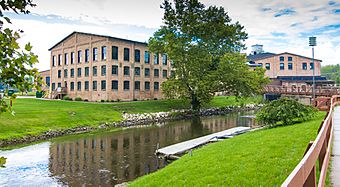Michigan Paper Company Mill Historic District facts for kids
Quick facts for kids |
|
|
Michigan Paper Company Mill Historic District
|
|
 |
|
| Location | 200 Allegan St., Plainwell, Michigan |
|---|---|
| Area | 9.7 acres (3.9 ha) |
| Built | 1887 |
| Architect | Daniel J. Albertson |
| NRHP reference No. | 11000636 |
| Added to NRHP | September 8, 2011 |
The Michigan Paper Company Mill Historic District, also known as the Plainwell Paper Company Complex, is a group of old factory buildings. You can find it at 200 Allegan Street in Plainwell, Michigan. This important historical site was added to the National Register of Historic Places in 2011. It tells the story of paper making in Michigan.
Contents
History of the Paper Mill
The story of paper making in this part of Michigan began in 1867. A man named Benjamin F. Lyon built the first paper mill in Kalamazoo. He was an experienced paper maker from Fitchburg, Massachusetts.
Starting in Plainwell
Even though his first business didn't work out, Lyon kept trying. In 1872, he teamed up with Hale W. Page, another paper maker. They built a new mill near downtown Plainwell. This area had just gotten a connection to the Michigan Central Railroad. This made it easier to move goods.
In 1887, Hale W. Page started a new company called the Michigan Paper Company. He partnered with local business people from Plainwell. They built a new paper mill right next to Lyon's 1872 mill.
Growing the Business
The Michigan Paper Company quickly became very successful. In 1890, they bought the B. F. Lyon & Co. Mill. That mill had stopped making paper just three years earlier.
In 1906, the company made its factory much bigger. They hired an architect named Daniel J. Albertson. He designed eight new buildings for the site. These new buildings helped the paper making process work like an assembly line. This made production much more efficient.
The company continued to do well. In 1910, they expanded again. They built a new office building. They also added more factory buildings that were similar to the 1906 ones. This gave the company two separate production lines.
Changes Over Time
In 1927, Michigan Paper bought a company that coated paper. In 1940, they moved the coating machines to the Plainwell factory.
Later, in 1954, a company called W.C. Hamilton and Sons bought Michigan Paper. It became part of the larger Hamilton Paper company. Michigan Paper started focusing on making special kinds of paper. Around this time, they built a new office building.
In 1961, Weyerhaeuser bought the company. Then, in 1970, it was sold to Philip Morris. They changed the name to the Plainwell Paper Company. They also continued to update the factory complex.
End of an Era and New Beginnings
The company was sold several times in the 1980s. Eventually, the mill stopped making paper in 2000. In 2006, the city of Plainwell bought the property.
Environmental cleanup started in 2007. In 2010, the city worked with a company to clean up and reuse the site. Some old buildings were taken down, and others were fixed up. In 2014, the Plainwell City Hall and the Plainwell Department of Public Safety moved into the complex.
What the Mill Looks Like
The Michigan Paper Company Mill Historic District has many buildings. There are over a dozen two- and three-story buildings made of brick. You can also see a power house made of brick and terra cotta. There are some metal warehouses, water towers, and storage tanks. There are also old rail lines where trains used to bring materials. The buildings in the complex were built between 1887 and 1995.
Original Buildings
The first mill from 1887 was shaped like an "L." It had a one-story machine room and a two-story main building. The machine room was taken down in 1906. But the main building is still there. It was turned into offices in 1975. Today, it is known as buildings 19 and 20.
Later Additions
Most of the buildings from 1906 and 1910 are still standing. These include:
- The first machine room (building 10)
- The beater room (building 11)
- The finishing room (building 16)
- The stock house (building 17)
- The chemical and duster room (building 18)
- Another finishing room (building 15)
The finishing room (building 15) was changed a lot in 1953.
The buildings from 1910 include:
- The second stock house (building 1)
- The second cooker room (building 2)
- The second beater room (building 3)
- The second boiler house (building 6)
- The second machine room (building 9)
A few other buildings were built in the 1930s and 1940s.



